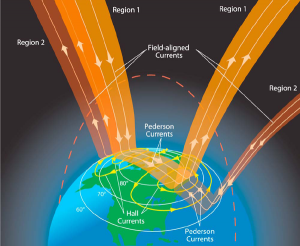Birkeland current
A Birkeland current is a set of currents that flow along geomagnetic field lines connecting the Earth’s Magnetosphere to the Earth's high latitude Ionosphere. In the Earth’s magnetosphere, the currents are driven by the solar wind and interplanetary magnetic field and by bulk motions of plasma through the magnetosphere (convection indirectly driven by the interplanetary environment). The strength of the Birkeland currents changes with activity in the Magnetosphere (e.g. during substorms).
Small scale variations in the upward current sheets (downward flowing electrons) accelerate magnetospheric electrons which, when they reach the upper atmosphere, create the Auroras Borealis and Australis. In the high latitude ionosphere (or auroral zones), the Birkeland currents close through the region of the auroral electrojet, which flows perpendicular to the local magnetic field in the ionosphere. The Birkeland currents occur in two pairs of field-aligned current sheets. [1]
Electric Current in Space Plasma
A Birkeland current generally refers to any electric current in a space plasma, but more specifically when charged particles in the current follow magnetic field lines (hence, Birkeland currents are also known as field-aligned currents). They are caused by the movement of a plasma perpendicular to a magnetic field. Birkeland currents often show filamentary, or twisted "rope-like" magnetic structure.
Originally Birkeland currents referred to electric currents that contribute to the aurora, caused by the interaction of the plasma in the Solar Wind with the Earth's magnetosphere. The current flows earthwards down the morning side of the Earth's ionosphere, around the polar regions, and spacewards up the evening side of the ionosphere. These Birkeland currents are now sometimes called auroral electrojets. The currents were predicted in 1903 by Norwegian explorer and physicist Kristian Birkeland, who undertook expeditions into the Arctic Circle to study the aurora.
Professor Emeritus of the Alfvén Laboratory in Sweden, Carl-Gunne Fälthammar wrote (1986): "A reason why Birkeland currents are particularly interesting is that, in the plasma forced to carry them, they cause a number of plasma physical processes to occur (waves, instabilities, fine structure formation). These in turn lead to consequences such as acceleration of charged particles, both positive and negative, and element separation (such as preferential ejection of oxygen ions). Both of these classes of phenomena should have a general astrophysical interest far beyond that of understanding the space environment of our own Earth." [2]
